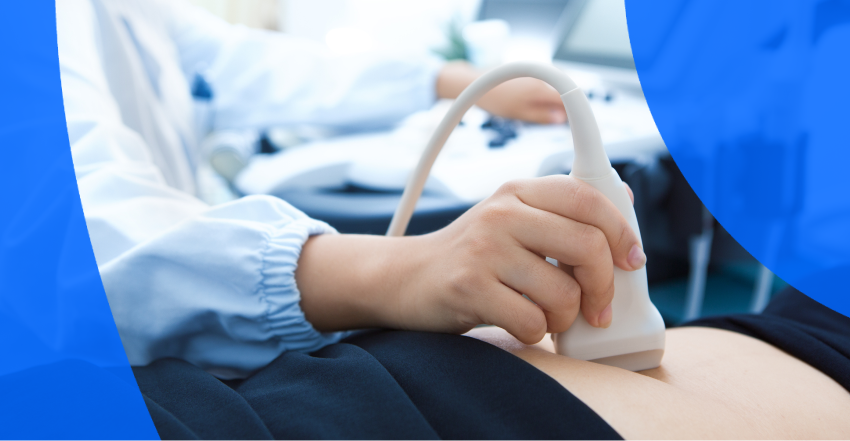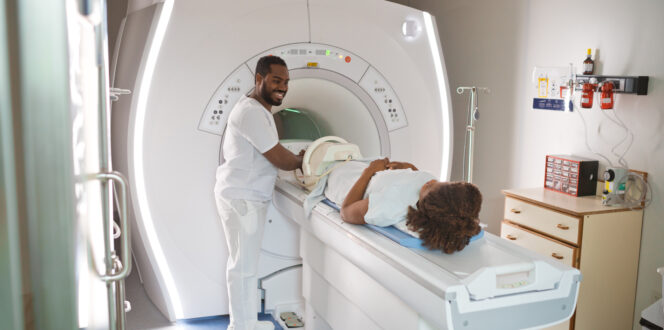What You Need to Know About an Abdominal Ultrasound Scan

An abdominal ultrasound scan can help your doctor diagnose or rule out kidney, liver, pancreatic or other conditions. Here’s what to know before your next appointment.
If you have sudden or unidentified pain in your belly or side or experience severe unexplained bloating, you may be referred for an abdominal ultrasound. The live images produced by an ultrasound can help your doctor diagnose and locate abnormal conditions or injuries, and to monitor the progress of their treatment.
An ultrasound is a safe and painless scanning method. If you’re wondering what an abdominal ultrasound might reveal, this article will break down:
- What an abdominal ultrasound is and how it works
- What an abdominal ultrasound might show
- What to expect during your appointment
- Questions to ask during and after your abdominal ultrasound
- How to access your abdominal ultrasound results
What is an abdominal ultrasound scan and how does it work?
An ultrasound is a safe, low-risk imaging scan that uses sound waves to create pictures of the internal structures of your body. The ultrasound technician, also known as a sonographer, uses an instrument called a transducer to transmit high-frequency sound waves into your body through a sound-conducting gel. Those sound waves create echoes when they meet your internal organs and tissues, which are then compiled into live images that can be seen on a monitor.
Your abdominal cavity contains several organs, including the gallbladder, intestines, kidneys, liver, pancreas and spleen, as well as bile ducts, the aorta and other blood vessels. An ultrasound can help your doctor locate and diagnose many different conditions or abnormalities that can arise in that region, as well as sites and signs of injury. You might be sent for an abdominal ultrasound for several reasons, including:
- Biopsy: doctors often use live ultrasounds to accurately place biopsy needles
- Bloating: to locate the source and cause of unexplained abdominal bloating
- Blood flow: a specialized Doppler ultrasound can assess and measure blood flow
- Function test: to identify or rule out abnormal functions in your kidneys or liver
- Enlargement: to check if any of your abdominal organs are unusually large or swollen
- Hernia: to confirm or eliminate the possibility of a hernia
- Infection/injury: to diagnose or locate the site of an abdominal injury or infection
- Pain: to source the cause of sudden or severe pain in your abdomen, back or side
- Screening: to screen for aortic aneurysms, especially if that risk runs in your family health history
What can an abdominal ultrasound show?
Depending on your situation and circumstances, an abdominal ultrasound might reveal any number of different abnormalities, including:
- Abscesses: soft masses filled with pus
- Blood vessel restrictions: whether partial reductions or full blockages
- Cysts: thin-walled sacs full of fluid
- Fatty liver: an excessive buildup of fat covering the organ
- Hard deposits: such as gallbladder or kidney stones
- Hernia: an organ or tissue pushing into a space it shouldn’t occupy
- Liver disease: acute or chronic, including cancer or cirrhosis
- Organ enlargement: unusually oversized or swollen organs
- Organ infection: such as appendicitis or pancreatitis
- Tumors: abnormal cell or tissue growths (not all tumors are cancerous)
Since ultrasounds are live, they can also capture the movement of blood through vessels, though that may require a specialized Doppler ultrasound.
While ultrasounds can give doctors an excellent view, they may have limitations depending on what they reveal. You may require supplemental imaging for clarification. For instance, if an abdominal ultrasound shows a tumor-like mass, a biopsy or CT scan might be needed to identify if the tumor is benign or cancerous.
What to expect during an abdominal ultrasound appointment
An abdominal ultrasound is an external procedure. Depending on the area being scanned, you’ll lie on your back or side. The ultrasound technician will cover your skin with conductive gel, and then run the transducer through it. Abdominal ultrasounds generally last between 30-60 minutes.
There are some things you can do to prepare for your abdominal ultrasound:
- Bring a copy of your requisition with you, as it contains important information for the imaging clinic about the type of ultrasound scanning you need.
- Read the instructions on the requisition or check with the clinic ahead of time to find out if there are any special requirements for your particular ultrasound. For instance, for a general abdominal scan, you’ll have to refrain from eating or drinking for 8-12 hours before your ultrasound. For a kidney scan, however, you’ll have to drink at least 24 ounces of water.
- Wear loose, comfortable clothing to your appointment, as you’ll likely have to change into a gown, and remove any jewelry.
Questions to ask during an abdominal ultrasound scan
Your ultrasound technician can’t answer questions about the results of your scan, but you can ask questions about the procedure, such as:
- How long will this scan take?
- How will you share my images with my doctor?
- When will my doctor get the images and report?
- How can I access the images and report?
Questions to ask during your abdominal ultrasound follow-up appointment
The ultrasound technician is not legally allowed to discuss the findings of your scan with you. Your sonographer will forward the images to the radiologist for interpretation, then the radiologist will send the images and a report to your referring physician. After that, your doctor will set up a follow-up appointment with you to discuss the results.
Here are some questions you might want to ask your doctor at your follow-up appointment:
- What did the ultrasound show?
- Was there anything unusual or unexpected?
- Do I need any further imaging or other tests?
- Did the radiologist make any recommendations?
- What are the next steps?
How do I access my abdominal ultrasound scan results?
When you’re in pain or suffering from new and unexplained symptoms, you likely want fast access to your results. With PocketHealth, you can have rapid access to your abdominal ultrasound images, often even before your follow-up appointment.
PocketHealth provides safe, secure access so you can see, read and store all your medical images and results in one place. You can view your abdominal ultrasound images in diagnostic quality, and share them with other medical specialists if required.
Radiologist reports can be full of complex medical terminology. PocketHeath Report Reader can help you understand what you’re reviewing by providing definitions of medical terms. Report Reader will also spotlight any follow-up recommendations, so you’ll always be completely up-to-date when you meet with your doctor to discuss your results. Access your records today.
Take control of your abdominal health
If you experience strange or sudden symptoms in your back, belly or side, an abdominal ultrasound can provide valuable insight. Abdominal ultrasound images can help your healthcare team diagnose illness or identify injuries, and monitor the course of any recommended treatment. If you have access to your abdominal ultrasound images and report, you can have more engaged and informed conversations with your doctor.
Get fast, secure access and a better understanding of your health by using PocketHealth. With all your medical images and results in one place, you’ll be in the driver’s seat when it comes to your health journey.
How PocketHealth works
Learn more about how to use PocketHealth to access and share your abdominal ultrasound results.
Published: November 24, 2023
Trusted by more than 800+ hospitals and clinics.



















